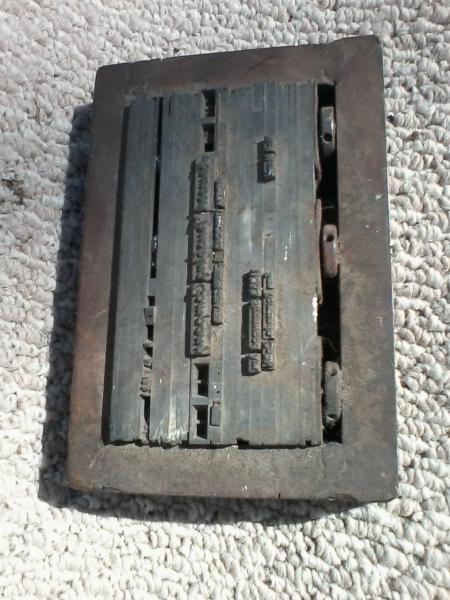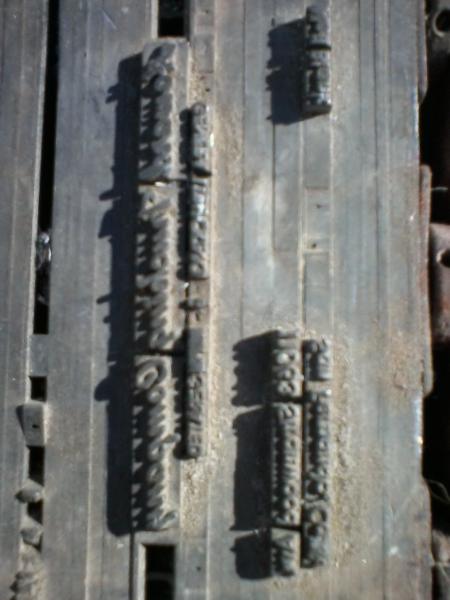3x5 chase for which press? (See images)
My aunt passed away and I am cleaning out some of her attic space. I have no idea why my aunt would have this chase to an old printing press in her attic. I do not know which press it comes from. It measures 4x6 on the outside and 3x5 on the inside. See below images.
Perhaps it is a part I can advertise in your classifieds that a printer enthusiast might need or want. I am a collector of older automobiles and could not find it in my heart to just give this part to a Goodwill without attempting to see if there is anyone out there who might really need it for their collection. - If there is another website you might direct me to for this information, then that would be very helpful also.
Are those lead linotype plates in the chase?
(I am new to this site. If I should have posted this in another category or with better protocol, then please let me know.)
Thank you very much.
Brad G

0105141319.jpg
chase3.JPG

0105141320a.jpg
Good on you. I cant ID it but keep a hold of it. It is either Linotype or Ludlow. Either way someone will turn up who will need that Chase! Besides being a printer/photographer I love my Austin Healey Sebring and I’m always scrounging windows and doors and bumpers and whatever!
Its an interesting lock up arrangement, havent seen that, I’m only familiar with small Adana presses.
B G 2004 Sir, I have an Adana 5 x 3 chase in front of me now it measures, of course 5” x 3” outside (in actual fact 1 16th of in inch short in each case) because the smaller, Adana chases are die-cast with crap metal, they are made with thicker wall thickness, consequently the inside measurement is actually, 2 & 3/8” x 4 & 5 16ths of an inch, so the publicity from a long time ago would appear to be just a little misleading.
It was not uncommon to see smaller jobs locked into tiny chases, used as adaptor chases on bigger machines, to save furniture, in essence the principle “borrowed” from SPIDER chases, from bigger machines whereby the print area image was positioned in the centre box of the chase and saved masses of furniture.
This may be possibly one such case, plus the chase shows signs of welded repair at right hand side, one of 2 possibilities, *A* straight forward repair for breakage, although it looks too precise and clean, or best probability? *B* it was fairly common practice to cut down and re-weld a very elongated, letterbox style chase, down to precisely your item!!! . . Just possibilities.??
The type is almost certainly standard Monotype or Founders , same difference basically, the Main line is probably 14 point in a script based face, the 2 lower lines are probably 10 -12 point, the line immediately under the main line is probably, 8 point, the spaces on the main line are multiples from a Giant Caster, and would have been used exactly as pictured i.e. to space a centered item as quick as possible.
The tiny pin holed devices are in fact, 3 narrow margin Quoins, A VERY NICE FIND?? i.e. not very common and to smaller Kelsey, Sigwalt, Adana users, very desireable???
DONT get Bushwacked if/when you sell!!
The lead plates that you refer to are standard spacing material, with possibly 2 variations, Ludlow as our friend above has implied, or more than likely, Monotype spacing from the Giant Caster, if you choose to unlock it ,with an ordinary tommy pin, and carefully check you will probably find, your, lead plates, are in the denominations of, by thickness, 6 point. 3 point, and 2 point. Good Luck.
Might this be related to the making of rubber stamps? It seems odd that it has a heavy solid back- maybe it was to conduct heat in the stamp-making process.
DGM
The script type is certainly not Linotype, Slant of type and kern proves that. And they are not Ludlow script either because they have vertical rather than angled sides.
Overall I’d guess it is a handset form for rubberstamp molding or foil stamping. No inked printing press chase I’ve seen has a solid floor. And why are there no quoins on the sides? That suggests that the chase is only used face up, not in a tabletop platen, but rather in a molding or stamping press.
The Plot Thickens, quite interestingly, with one dodgy eye and only one fairly good one???. . The middle shot of the three fairly clearly shows, 6 (SIX) holes drilled right through, 2 blocks of three, with line of sight in the background, part of human hand??? so unless there is some on line illusion, shots ONE & THREE are not the face(s) of shot TWO?? By implication the middle shot is a wrong font, in the context of the original query, or a *red herring* in laymans terms???
From a time long gone, but still interesting to see the conundrum resolved.
As Mick says(Happy N Y Mick), nice micro coins, if anyone is interested in these polymetaal.nl have started to sell new ones.
Jonathan, Thank you, I return the greeting, and it is pleasing that what originally appeared to be a case for the *Armchair Detectives, or L/press print archivists* has thrown up your info,?? which will I am sure be useful to *Baby* Sigwalt, Kelsey, Adana and similar new devotees/users, trying to get the most from the least!!!
But you, as the author of your post, really should have words with the *Proof Reader* in your College of Knowledge,”“” QUOINS,”“”— Your Charges, could be taught how to use, and probably have been Already!!! . . “”“COINS,”“” would come into play in the coffee shop, the refectory, or the pub.???
NON intended, and My excuse will always be, one dodgy eye, jumble sale glasses spattered with lead particles, or cutting fluid from the lathe,.!!!
_____ Thank you everybody who responded to my post. Per The Arm’ and P_I’s posts I think I found pertinent information from the web. Possibly the linotype is lead cast in one piece and then fitted into the chase for making a rubber stamp…, or used for embossing, and/or hot foil stamping? See below.
“Third is the use of the really old fashioned linotype molding machines (e.g., Ludlow) that actually mold a newspaper column width line of type at a time.”
“This used to be printing industry standard and works fine for rubber stamps, but is quite cumbersome.”
“There are a few around today only because newspapers and other printers have sold (or given them away) to upgrade to modern printing equipment) these machines use molten lead, are quite large, and understandably generate a lot more heat.”
“When you type a line, molten lead is forced into its internal molds to produce a standard line of type, in whatever style molds that have been placed in the machine.. Once the line of type is cooled, it is placed in a chase and made the same way as foundry type stamps.”
* Source: MSM Marking Devices and Equipment website; Stamp making methods; #3 Linotype Method ; (Paragraph 4) http://www.msmmarking.com/how-to-make-stamps.shtml
_____ Then from paragraph 2 of that same source ( #1 Hand-Set “Foundry” Method ).
“When assembled, the chase is tightened to hold the “copy” firmly in place and a trimmed piece of specially treated, plasticized board (matrix) is placed over the design. The chase and matrix are then placed in a machine that applies measured heat and pressure which gently squeezes the layout in the chase into the matrix and leaves a positive impression of the desired stamp in the matrix, which is allowed to cool and cure.”
“Since matrix is a thermosetting plastic, it can be molded only once; it will not soften when re-heated. Raw rubber is then cut to size and pressed into the matrix by the same heat and pressure machine. When the rubber is “cured” ( 2 or 3 minutes), it is trimmed, glued to a mount, and PRESTO, a rubber stamp!
During the molding process, powder is used to prevent sticking — and plain baby talc works great.”
_____ It would be nice to find the actual press the chase went to. I checked around the net and found some presses but they aren’t vintage, or, their chases aren’t pictured.
_____ Below is one picture I found of a vintage rubber stamp heat embossing machine from Ebay. Note the chase has a bottom and has quoins only on one side.
_____ (Thanks for your-all’s patience. I am not a printer, and had to look up a bunch of words to be able to communicate what I wanted to say this far. Hope the translation wasn’t too garbled. And anything else you might want to add would be greatly appreciated as well. - I will probably do a few more searches to see if I can nail it down some more. Will let you know if I find anything.)
http://www.ebay.com/itm/VINTAGE-WARNER-46-ELECTRIC-RUBBER-STAMP-HEAT-EMBOSSING-VULCANIZING-MACHINE-2-/300955376770
Vintage_ stamp_making_machine.JPG
There were quite a few different rubber stamp presses made, I have run across all kinds of different chases, some with bottoms and some without. I still make rubber stamps from Ludlow or linotype, I have two presses like the one shown in your picture. I worked in a commercial plant that had a press that you could make a stamp about 4 feet wide and 6 feet long, some presses took a special chase (like the one in your picture) others you could use different chases. Most machines are heated by electricity, the big ones I saw in the commercial shop were heated by steam.
I must have been thinking cost wise subconsciously of the coins for the quoins , Mick……………
B G Sir, Just from the amount of column inches above, looks like a lot of work and research, well done!!
As you are inviting input to aid your efforts, perhaps, (you have briefly touched on it , by another name) look up,
PHRENOLTHIC BOARD and the process of making FLONGS to reverse the process, to fabricate either Flat Stereos, for standard Letterpress, (which could be chemically Copper faced for extra longevity) OR Curved Stereos for wrap around, on newspaper presses!!! In Giant Form, in essence, exactly as your research points to.?? Good Luck.
polymetaal.nl also selling new-quite long-composing sticks http://www.polymetaal.nl/siteUK/shopukwork/enter.html
micro coins do not seem to be coming up as a link but just email Hugo
Guys & gals,
I posted this chase up on eBay. - In case you’re interested. Pass it on if you know of anyone who might need this chase. And let me know of any other printing websites I might post this item in case someone is interested in it for their own collection or very own press.
http://cgi.ebay.com/ws/eBayISAPI.dll?ViewItem&item=141176389548